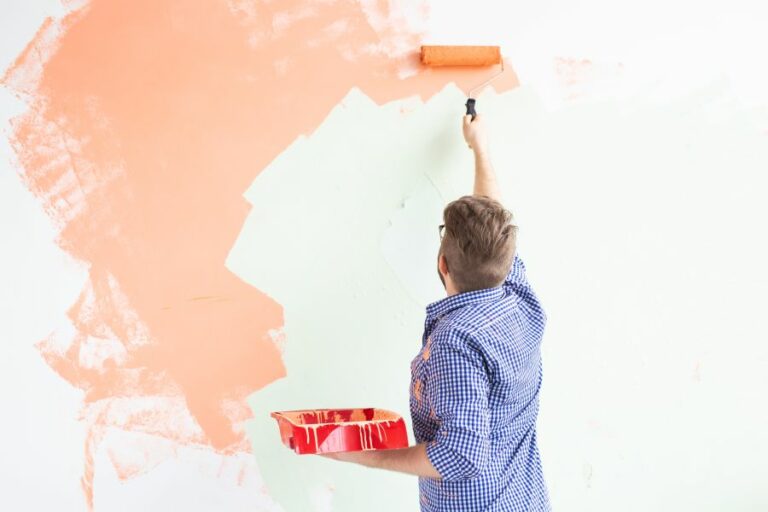Outdoor Porch Paint, 25 Things You Should Know
Are you thinking of giving your outdoor porch a fresh, new look? A splash of paint can make a world of difference, and our comprehensive guide on ‘Outdoor Porch Paint’ is here to help. From selecting the right paint to step-by-step application tips, we’ll walk you through the entire process. Transform your porch into a captivating and welcoming space that will be the envy of your neighborhood.
Outdoor porch paint:
Porch paint is essential to enhance aesthetics and protect against wear and tear. Oil-based paint offers durability and weather resistance, while latex-based paint dries quickly and is eco-friendly. Consider factors like surface material, climate, safety, and color when choosing paint. Ensure proper preparation, primer application, and maintenance for a lasting finish.

Discover the perfect outdoor porch paint to elevate your home’s curb appeal. Explore various types, colors, and finishes while learning expert tips for application and maintenance. Unveil the porch of your dreams with this comprehensive guide.
Contents
- 1 Exterior Patio And Porch Paint
- 2 What is the Most Suitable and High-Quality Paint for a Porch?
- 3 Is Primer Necessary for Porch Paint Application?
- 4 What Type of Paint Should You Utilize for a Wooden Front Porch?
- 5 Is it Necessary to Apply a Sealant to the Porch Paint?
Exterior Patio And Porch Paint
A porch is an integral part of a home’s exterior, and its appearance can significantly affect the overall aesthetics of a house. Outdoor porch paint not only adds color but also serves as a protective barrier against harsh weather conditions and general wear and tear.
• Porch Paint Types: Oil Based vs. Latex Based
There are two main types of porch paint to consider: oil-based and latex-based paints. Each type has its own set of benefits and drawbacks, which we will discuss in detail below.
– Oil-Based Paint
Oil-based paint has long been a popular choice for outdoor wood surfaces due to its durability, resistance to weather conditions, and smooth finish. Some benefits of oil-based paint include:
- Durability: Oil-based paint is long-lasting and can withstand heavy foot traffic and harsh environmental elements.
- Weather Resistance: This type of paint has excellent adhesion properties, making it less likely to chip or peel in extreme temperatures or moist conditions.
However, oil-based paint also has some notable drawbacks:
- Longer Drying Time: Oil-based paint can take a considerable amount of time to dry, sometimes up to 24 hours or more.
- VOC Emissions: Volatile Organic Compounds (VOCs) are emitted during the painting process and while the paint is drying, which can be harmful to the environment and your health.
– Latex-Based Paint
Latex-based paint is a popular alternative to oil-based paint due to its quick-drying properties, easy cleanup, and lower VOC emissions. Some benefits of latex-based paint include:
- Quick Drying: Latex-based paint dries quickly, usually within a few hours.
- Easy Cleanup: This type of paint is water-soluble, making cleanup simple and efficient with just soap and water.
- Lower VOC Emissions: Latex-based paint emits less VOCs, making it a more environmentally friendly option.
However, latex-based paint does have its own set of drawbacks:
- Less Durability: Latex-based paint is generally less durable compared to oil-based paint and may need more frequent reapplications.
- Adhesion: This type of paint may not adhere as well to certain surfaces, making it prone to peeling and chipping.
• Selecting the Ideal Porch Paint
When choosing a type of outdoor porch paint, consider the following factors:
- Surface Material: Assess the type of material your porch is made from, as different paints may adhere better or worse to specific surfaces. For example, oil-based paint works well on wood, while latex-based paint may be better for concrete or brick surfaces.
- Climate: The local climate and weather conditions can affect the durability and effectiveness of the paint. For example, if you live in a humid or wet environment, you may want to opt for paint with better weather resistance.
- Safety: Consider slip-resistant porch paint options to reduce the risk of accidents, especially if your porch is prone to moisture or dampness.
- Color & Style: Finalize the color and style you envision for your porch to achieve the desired aesthetic effect. Remember that lighter colors tend to hide dirt and debris, while darker colors can give a porch a more striking and dramatic appearance.
• Tips for Painting Your Porch
Once you have selected the ideal outdoor porch paint, follow these steps for the best results:
- Preparation: Clean the porch thoroughly and make any necessary repairs to ensure a smooth and even surface. Remove any peeling or flaking paint, fill cracks and holes, and sand down rough areas.
- Primer: Apply a high-quality primer to the surface to enhance paint adhesion and ensure a long-lasting finish. This is particularly important if you are using oil-based paint or if the porch material is difficult for paint to adhere to.
- Application: Apply the paint in thin, even coats with a paint roller or brush, following the manufacturer’s instructions. For best results, two coats of paint are typically recommended, allowing the first coat to dry completely before applying the second.
- Maintenance: Regularly clean and maintain your porch to preserve the paint’s appearance and prolong its lifespan. This may include sweeping away debris, washing with soap and water, and reapplying paint or sealant as needed.
In conclusion, selecting the right outdoor porch paint is crucial for enhancing the beauty and durability of your porch.
Consider factors such as surface material, climate, and color preference when making your decision, and follow the proper steps for preparation and application to achieve a professional and long-lasting finish.
What is the Most Suitable and High-Quality Paint for a Porch?
A porch is an ideal space for relaxation, entertainment, and adding aesthetic value to your home. To protect this vital outdoor area and keep it looking great, it’s essential to choose the best paint for the job.
• All About Porch Paints
There are numerous factors to consider when selecting paint for your porch, such as durability, appearance, and effectiveness against various weather conditions. Below are some of the most popular and reliable paint types for porches.
– Oil-Based Paints
Oil-based paints have long been a favorite for adhesion and durability, making them suitable for wooden or concrete surfaces. These paints can better withstand frequent foot traffic, resist fading, and offer excellent coverage.
However, oil-based paints can take longer to dry, often needing 24 hours between coats. For best results, we recommend using a primer before applying oil-based paint.
Recommended Product: Valspar Anti-Skid Porch & Floor Paint
This oil-based paint delivers a semi-gloss finish, providing a durable and slip-resistant surface. It’s excellent for both wood and concrete and can be tinted in various colors to match your preferred aesthetic.
– Water-Based Paints
Water-based paints, also known as latex or acrylic paints, are popular for their easy application and cleanup. These paints typically dry faster than oil-based options and are less prone to yellowing as they age.
However, they may not be as durable as oil-based paints so they may wear off quicker in high-traffic areas, especially in extreme weather conditions.
Recommended Product: KILZ Interior/Exterior Enamel Porch & Patio Latex Floor Paint
This high-durability, water-based paint is ideal for both wood and concrete surfaces. It provides a mildew-resistant finish and comes in a satin or semi-gloss finish. Suitable for all weather conditions, this paint is perfect for enhancing your porch’s aesthetic appeal while providing protection.
– Epoxy Resin Coatings
For extra durability and protection against oil, grease, and various chemicals, epoxy resin coatings are the top choice. These two-part coating systems consist of a base and a hardener mixed in equal parts before application.
Epoxy coatings also have excellent adhesion capabilities and are resistant to peeling or chipping, making them suitable for concrete surfaces.
Recommended Product: Rust-Oleum EPOXYSHIELD Concrete Floor Paint
This epoxy coating system delivers excellent protection against chemicals, UV rays, and abrasion. The high-performance formula dries quickly, allowing you to use your porch with minimal downtime.
The epoxy coating also comes in a variety of colors, allowing you to choose a shade that blends with your home’s overall design.
• Preparing Your Porch for Painting
– Surface Preparation
Proper surface preparation is crucial for ensuring the paint’s adhesion and longevity. Start by thoroughly cleaning the surface, removing dirt, mold, mildew, and any loose or flaking paint with a power washer or stiff-bristle brush. Allow the surface to dry completely before moving to the next step.
– Repair Cracks and Damage
Inspect your porch for cracks or damaged areas, and repair them before painting. Use a high-quality wood filler for wooden surfaces or a self-leveling caulk for concrete surfaces. This will ensure your paint job lasts longer and looks great.
– Primer Application
Applying a primer before painting improves adhesion, prevents peeling, and increases the paint’s life. Choose a primer designed for the type of paint and surface you’re working with, and follow the manufacturer’s instructions for application.
• Painting Your Porch
After preparing the surface and applying primer, it’s time to paint. Use a brush, roller, or paint sprayer for an even application. For the best durability and performance, we recommend applying at least two coats of paint. Allow ample drying time between coats based on the specific paint and weather conditions.
• Conclusion
Your porch is a valuable extension of your home and deserves proper maintenance and protection. By choosing the best paint for your porch, you can ensure its durability, enhance its appearance, and maximize its lifespan.
Consider each paint type’s benefits and drawbacks, and try out our recommended products to achieve the perfect porch paint job.
Paint Brand | Type | Description |
|---|---|---|
Behr Premium | Low-Lustre Enamel | Durable finish that resists scuffing, fading, cracking, and peeling. Suitable for wood and concrete surfaces. |
KILZ Interior/Exterior | Enamel Porch & Patio Paint | Water-based acrylic formula designed for high-traffic surfaces. Resists scuffing, fading, and peeling. |
Rust-Oleum Porch & Floor | Urethane Modified Acrylic | Scratch and weather-resistant finish for wood and concrete. Offers long-lasting protection and color retention. |
Valspar Latex Porch & Floor | Latex Satin | Water-resistant, scuff-resistant, and fade-resistant. Ideal for both interior and exterior use. |
Is Primer Necessary for Porch Paint Application?
A well-maintained porch not only enhances the curb appeal of your property but also plays a significant role in maintaining the structural integrity of your home.
Since porch surfaces are often exposed to harsh weather conditions, foot traffic, and heavy furniture, the quality of your paint job plays a crucial role in ensuring that your porch remains unblemished.
As a homeowner, you probably have wondered whether porch paint always requires a primer or if it is possible to skip this step for a quicker and cost-effective process.
• Understanding the Role of Primer
Before delving further into the role primer serves in porch painting, it is essential to understand what primer is and what it does. Primer is a preparatory coating applied before the actual paint, primarily to enhance adhesion, provide better coverage, and prolong the durability of the paint job.
– Benefits of Primer
- Adhesion: Primer improves the adhesion between the surface and the paint, ensuring a longer-lasting paint job and preventing peeling and flaking.
- Coverage: Primers help cover existing stains, dark colors, and imperfections on the surface, allowing for a uniform, seamless appearance when the paint is applied.
- Durability: A well-applied primer helps strengthen the paint film, resulting in a more durable and long-lasting paint job.
- Porch longevity: If the wood is unprotected, it may be susceptible to rot, mold, and other forms of damage. Priming helps protect the wood from these issues over time, therefore prolonging its lifespan.
• When to Use Primer for Porch Painting
– New wood surfaces and unpainted porch
Priming is essential if you are working on new wood or a previously unpainted porch, as it ensures proper adhesion of the paint, sealing the wood to protect against damage from elements like moisture and sunlight.
– Repainting with a different color
If you are repainting your porch and plan to change the color significantly, particularly from a darker color to a lighter one, applying a primer can save both time and money. The primer seals the existing color, allowing the new color to show more accurately with fewer coats.
– Porch with visible damages or stains
If the porch has water stains, rust, mildew, or other damage, using a primer can help cover these imperfections and create a better overall finish. In some cases, a specialized primer may be required to block certain types of stains.
• When to Skip Primer When Painting Your Porch
– Repainting with the same or similar color
If you already have a well-adhered base coat and plan to repaint it with the same or similar color, you may be able to skip the primer stage. As a professional, I always recommend testing the adhesion of the existing paint by making a small X with a utility knife and applying a piece of masking tape over it.
Press the tape firmly and then pull it off. If the paint remains on the surface with no lifting or peeling, the adhesion is adequate, and you can proceed without using primer.
– Using paints with built-in primer
In recent years, paint manufacturers have developed products that contain both paint and primer in one formula. These products save time and effort as you can apply the paint directly onto the surface without needing a separate primer.
However, preparing the surface properly by cleaning, sanding, and repairing any damage before applying the paint is still essential.
• Tips for Choosing the Right Primer for your Porch
- Match the primer to the type of paint and surface: Choose a primer that is compatible with the paint you intend to use and is also suitable for the material of your porch (wood, concrete, etc.).
- Consider the specific needs of your porch: If your porch faces severe weather conditions, high foot traffic, or significant exposure to sunlight, opt for a primer formulated to address these challenges.
- Read the manufacturer’s recommendations: Always follow the manufacturer’s guidelines for using the primer and the recommended drying time for optimal results.
In conclusion, whether or not your porch paint requires a primer largely depends on the specific situation and conditions of your porch.
By taking into account the factors outlined in this article and implementing them accordingly, you can ensure an impeccable and durable finish for your porch, enhancing your home’s overall appearance and longevity.
What Type of Paint Should You Utilize for a Wooden Front Porch?
A wooden front porch can be a beautiful and welcoming addition to any home. To ensure that it remains as welcoming and charming as the day it was built, it’s important to choose the right kind of paint.
Not only does the correct paint prevent wear and tear, but it can also protect your porch against weather, temperature fluctuations, and even insects.
• Type of Paint: Water-Based vs. Oil-Based
There are two main types of paint that you can choose from for your wooden front porch: water-based and oil-based. Understanding the characteristics of each type of paint can help you make the right choice.
– Water-Based Paint
Water-based paint, also known as latex or acrylic paint, is the most environmentally friendly option, with low levels of volatile organic compounds (VOCs). This type of paint is easy to clean using soap and water, making it a convenient option for homeowners.
In terms of durability and weather resistance, high-quality water-based paint can provide excellent protection and lasts a long time.
Advantages of water-based paint:
- Low levels of VOCs
- Dries quickly
- Easy to clean
- Resistant to peeling and cracking
– Oil-Based Paint
Oil-based paint, or alkyd paint, has been a preferred choice for many years. It offers robust protection for your wooden front porch against moisture and harsh weather conditions. Oil-based paint also resists cracking and creates a smooth, glossy finish.
However, it’s important to note that this type of paint takes longer to dry and has a stronger odor compared to water-based paint.
Advantages of oil-based paint:
- Excellent durability
- Highly resistant to moisture and weather conditions
- Longer drying time can lead to a smoother finish
• Choosing the Right Finish
The right finish can give your wooden porch a distinctive look while providing protection against damage. There are three primary finishes to choose from:
– Flat or Matte Finish
A flat or matte finish offers a non-reflective surface that hides imperfections well, making it suitable for rough or weathered wooden surfaces. However, this type of finish is less resistant to moisture and stains, so it may not be the best choice for a high-traffic porch area.
– Satin or Eggshell Finish
A satin or eggshell finish is ideal for wooden front porches that experience moderate to high levels of foot traffic. This finish provides a low-luster sheen that adds visual interest without being overly glossy. Plus, it’s easier to clean and maintain compared to a flat finish.
– Gloss or Semi-Gloss Finish
A gloss or semi-gloss finish gives your porch a shiny, polished look that showcases the wood’s natural beauty. This type of finish is highly durable, easy to clean, and resistant to moisture and stains.
Additionally, it’s well-suited for porch railings and trim, providing a nice visual contrast against a less glossy surface.
• Selecting a Porch Paint Color
One final consideration when choosing paint for your wooden front porch is selecting the right color. Popular porch paint colors include classic white, warm neutrals, and various shades of gray, green, blue, or red.
The key is to choose a color that complements your home’s exterior and enhances its curb appeal. Additionally, consider the following factors when selecting a paint color:
- Sunlight exposure: Direct sunlight can cause paint to fade over time, so choose a paint color that will maintain its vibrancy even with constant sun exposure.
- Porch size: Lighter colors can make a small porch appear larger, while darker colors can make a larger space feel cozy and welcoming.
- Maintenance: Lighter colors may show dirt or stains more quickly, so consider the level of maintenance you’re willing to commit to when selecting a porch paint color.
• In Conclusion
When painting a wooden front porch, it’s important to choose the right paint type, finish, and color. Weigh the pros and cons of water-based and oil-based paint, as well as the benefits of different finishes, before making a final decision.
Additionally, consider your home’s exterior and porch size when selecting a paint color. By taking these factors into account, you can protect and enhance your wooden front porch for years to come.
Is it Necessary to Apply a Sealant to the Porch Paint?
A well-painted porch can elevate the aesthetic appeal and increase the durability of your outdoor space. While it’s common to wonder whether porch paint needs to be sealed, the answer depends on several factors.
• Factors to Consider
Before determining if your porch paint needs to be sealed, consider the following factors:
– Porch Material
Different materials react to paints and sealants differently. Wood, for example, may benefit more from sealing than concrete, since wood is porous and more prone to moisture damage.
– Climate and Weather Conditions
The need for sealing porch paint might be higher in areas with harsh weather conditions, like continuous exposure to direct sunlight, heavy rainfall, or high humidity levels.
– Paint Type and Quality
High-quality porch paints usually have built-in sealing properties that provide adequate protection to the painted surface. Ensuring that you’re using a paint specially designed for outdoor use will greatly impact the overall durability and resistance to weather conditions.
– Porch Usage
A heavily used porch, subject to high foot traffic and potential wear and tear, may benefit from additional protection provided by a sealer.
• Benefits of Sealing Porch Paint
If you’ve considered the factors mentioned above and have decided that adding a sealer might be beneficial, the following are some of the advantages you can expect:
– Enhanced Durability
Sealing your porch paint can significantly extend the life of the paint job, protecting it from fading, chipping, and weather damage. This means you won’t have to repaint your porch as often, ultimately saving time and money in the long run.
– Increased Water Resistance
Sealants can create a water-repellent barrier on the painted surface of your porch, which prevents moisture from seeping in and causing damage. This is particularly important for wooden surfaces that are more susceptible to rotting due to moisture.
– UV-Protection
Exposure to direct sunlight can cause paint to fade over time. A sealant with UV-blocking properties can protect your porch paint from fading, keeping your outdoor space looking freshly painted and vibrant for longer.
– Easier Cleaning and Maintenance
A sealed porch is easier to clean and maintain, as the sealed surface is less prone to stains and damage. Dirt, grime, and other debris are less likely to stick to the surface, making the cleaning process less strenuous and time-consuming.
• Choosing the Right Sealer
If you decide to seal your porch paint, it’s essential to choose the right type of sealer. There are various types of sealers available in the market, and it’s crucial to select one that’s compatible with both the material of your porch and the type of paint used.
– Acrylic Sealers
Acrylic sealers are a popular choice for sealing porch paint, as they provide a durable and breathable protective layer. They offer UV and water resistance, and they are available in different finishes, like matte, satin, or gloss.
Ensure that the acrylic sealer you choose is suitable for outdoor use and compatible with your porch paint.
– Polyurethane Sealers
Polyurethane sealers provide excellent durability, abrasion resistance, and chemical resistance. They are generally available in water-based or solvent-based variants, with water-based options being more environmentally friendly and offering easier cleanup.
As with acrylic sealers, make sure the polyurethane sealer you choose is appropriate for outdoor use and compatible with your porch paint.
• Sealing Process and Application Tips
Properly applying the sealant is essential to ensure the best results. Here are some helpful tips:
- Ensure that the porch paint is fully dry before attempting to apply the sealer.
- Clean the painted surface thoroughly, removing all dirt, debris, and dust.
- Apply the sealer using a brush, roller, or sprayer, following the manufacturer’s instructions for the best results.
- Apply multiple coats, allowing each coat to dry completely, as recommended by the sealer’s manufacturer.
- Reapply the sealer periodically as needed, based on the manufacturer’s guidelines, weather conditions, and usage.
• Conclusion
So, does porch paint need to be sealed? The answer depends on factors like the material of your porch, the climate, the type and quality of paint used, and the level of porch usage. Assess your unique situation and weigh the benefits before making a decision.
If additional protection is necessary, choose the right sealer and follow proper application guidelines for the best results. Your porch will not only look great but also stand the test of time.







